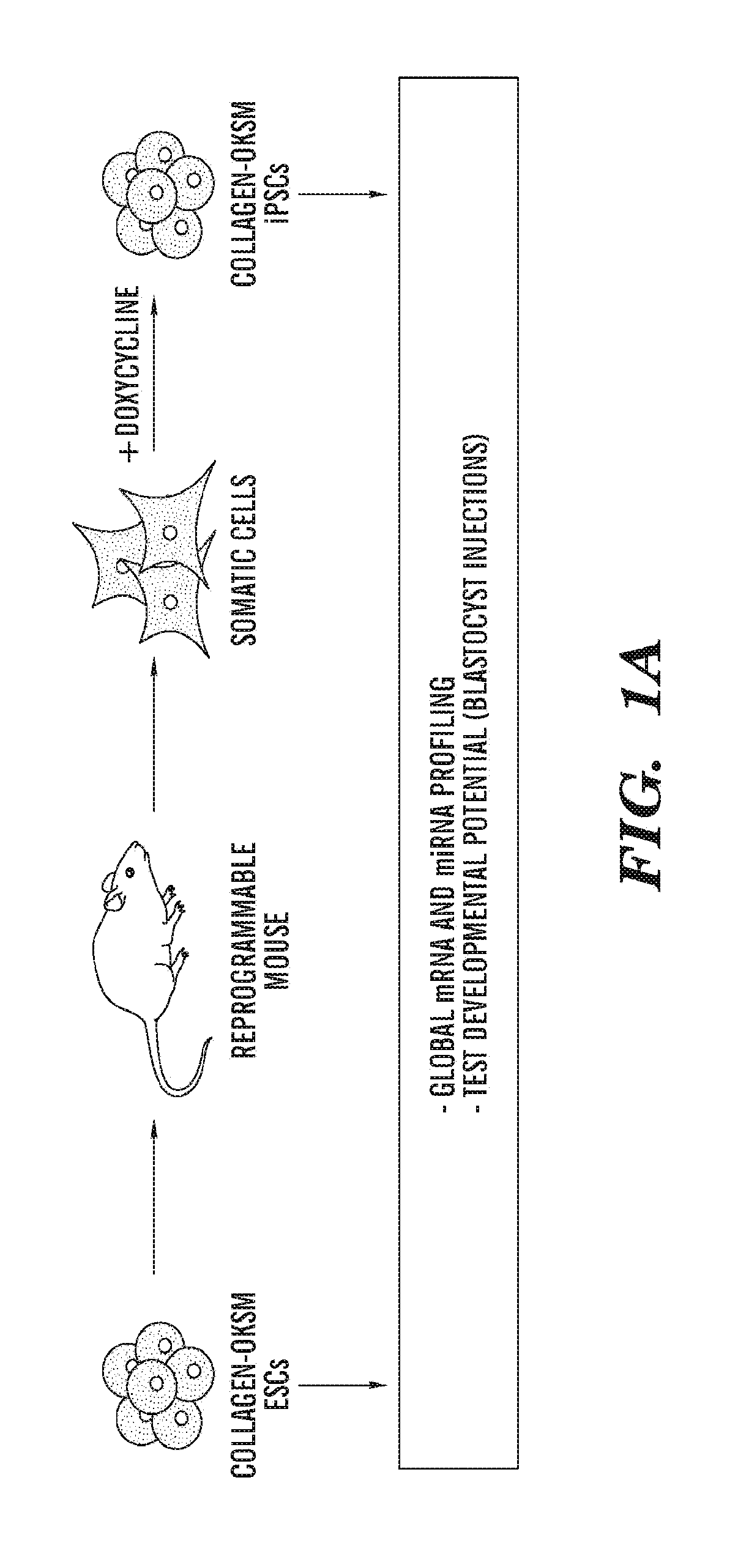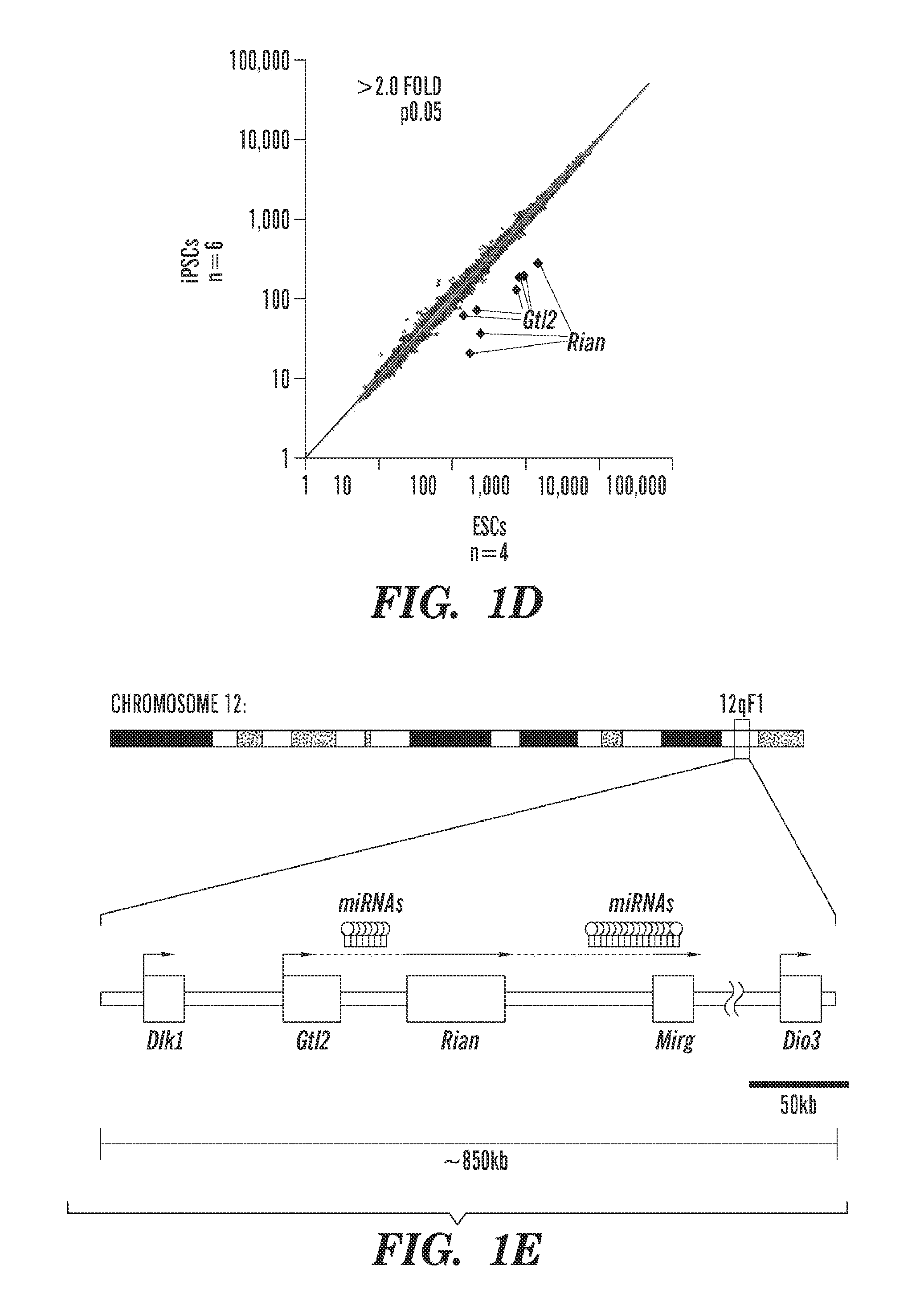Method for selecting an ips cell
a cell and ips technology, applied in the field of ips cell selection, can solve the problems of molecular and functional similarities/differences, remain unclear, etc., and achieve the effect of enhancing the differentiation potential of ips cells
- Summary
- Abstract
- Description
- Claims
- Application Information
AI Technical Summary
Benefits of technology
Problems solved by technology
Method used
Image
Examples
example 1
[0155]Genetically matched mouse ESCs and derivative iPSCs were used to screen for molecular and functional differences between these two pluripotent cell types. Briefly, a polycistronic cassette expressing Oct4, Klf4, Sox2, and c-Myc under the control of a doxycycline-inducible promoter was inserted into the Col1a1 locus of ESCs cells expressing the reverse tetracycline-dependent transactivator (rtTA) from the ROSA26 promoter (Stadtfeld, M. et al., Nature methods 7(1):53). These ESCs (designated Collagen-OKSM ESCs) were then used to generate mice from which different somatic cell types were isolated and induced with doxycycline to derive genetically matched iPSCs for molecular and functional comparisons (FIG. 1a,b).
[0156]First, the abilities of parental Collagen-OKSM ESCs and iPSCs derived from mouse embryonic fibroblasts (MEFs) that had been isolated from ESC-chimeric fetuses, to support the development of all-iPSC mice was compared using tetraploid (4n) embryo complementation (Nag...
example 2
Exemplary Methods for Use with the Methods Described Herein ESC and iPSC Derivation
[0172]Collagen-OKSM ESCs were generated by introducing a doxycycline-inducible version of a polycistronic reprogramming cassette encoding for Oct4, Klf4, Sox2 and c-Myc into the Collagen 1A1 locus. ESCs were then injected into blastocysts to derive chimeric mice, which were bred with ROSA26-M2-rtTA mice to derive a reprogrammable mouse strain (Stadtfeld, M. et al., Nature methods 7(1):53). Somatic cells were isolated from ESC-chimeras or the reprogrammable mouse strain and cultured in the presence of doxycycline to obtain iPSCs. ESCs and iPSCs were cultured under standard mouse ESC conditions.
Gene Expression Analyses
[0173]Total RNA was isolated from ESCs and iPSCs after removal of feeder cells and subjected to transcriptomal analyses using either Affymetrix U-133 μlus2.0 mRNA expression arrays (for mRNA analysis) or the miRCURY™ LNA Array (Exiqon) (for miRNA analysis).
Epigenetic Analyses
[0174]Genomic ...
example 3
Induced Increase in the Frequency of “Normal iPSCs”
[0187]We recently found that most iPSC lines have a more limited developmental potential than embryonic stem cells (ESCs), due to the aberrant silencing of important regulatory genes on chromosome 12 (called Dlk1-Dio3 cluster) in these iPSCs. A screen for molecules that might ameliorate this reprogramming abnormality was performed and two approaches were found that dramatically increased the frequency of “normal iPSCs”. These are 1) repression of an enzyme called Dnmt3a or 2) addition of ascorbic acid (Vitamin C) to do cell culture media during reprogramming (FIG. 15). This suggests that these straightforward modifications of the reprogramming procedure can be used to reproducible generate high-quality iPSCs at high frequency that can be used for disease modeling the study of developmental processes.
Reprogramming of Dnmt3a-Deficient Fibroblasts
[0188]Mouse embryonic fibroblasts (MEFs) harboring two conditional (“foxed”) alleles of Dn...
PUM
| Property | Measurement | Unit |
|---|---|---|
| time | aaaaa | aaaaa |
| compositions | aaaaa | aaaaa |
| Morphology | aaaaa | aaaaa |
Abstract
Description
Claims
Application Information
 Login to View More
Login to View More - R&D
- Intellectual Property
- Life Sciences
- Materials
- Tech Scout
- Unparalleled Data Quality
- Higher Quality Content
- 60% Fewer Hallucinations
Browse by: Latest US Patents, China's latest patents, Technical Efficacy Thesaurus, Application Domain, Technology Topic, Popular Technical Reports.
© 2025 PatSnap. All rights reserved.Legal|Privacy policy|Modern Slavery Act Transparency Statement|Sitemap|About US| Contact US: help@patsnap.com



